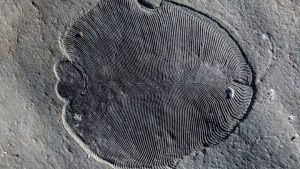Ed Yong in The Atlantic:
 Around 558 million years ago, a strange … something dies on the floor of an ancient ocean. Its body, if you could call it that, is a two-inch-long oval with symmetric ribs running from its midline to its fringes. It is quickly buried in sediment, and gradually turns into a fossil.
Around 558 million years ago, a strange … something dies on the floor of an ancient ocean. Its body, if you could call it that, is a two-inch-long oval with symmetric ribs running from its midline to its fringes. It is quickly buried in sediment, and gradually turns into a fossil.
While it sits in place, petrifying, waiting, the world around it changes. The Earth’s landmasses merge into a single supercontinent before going their separate ways. In the ocean, animal life explodes; for the first time, the world is home to eyes, shells, and mouths. Living things invade the land, coating it first in thin films of moss and lichens, and then covering it in huge forests. Insects rise, into existence, and then into the skies. A dinosaur empire rises and falls. Mammals finally take over, and one of them—a human by the name of Ilya Bobrovskiy—finally unearths the fossilized ribbed oval from its resting place.
All of which is to say: Five hundred fifty-eight million years is an incredibly long time.
But despite that almost unimaginable time span, and everything that happened within it, many of the simple molecules that once existed in the oval creature’s cells still persist. Bobrovskiy, a geochemist at Australian National University, has isolated, identified, and measured them. And they provide conclusive evidence that the creature, despite all appearances, is an animal. More specifically, it is the oldest animal ever discovered. It’s called Dickinsonia.
More here.
